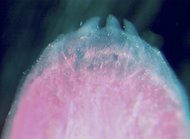Every once in a while in some science article in a newspaper or magazine in recent years, they'll talk about physicists who believe that there are more than three spacial dimensions. I'd squint and say "okaaay" and then the physicist will say something like "but you don't see the extra dimension because it's curled up really tiny!" and then my brain melts. In an effort to learn more about extra dimensions, string theory, and other brain melting aspects of modern high-energy particle physics, I recently decided to read a pop-science book about this kind of stuff. The book I chose, which had gotten some good recent reviews, was:
Warped Passages: Unraveling the Mysteries of the Universe's Hidden Dimensions, by Dr. Lisa Randall, available in hardcover at fine booksellers everywhere.
I'm not going to lie to you and pretend I understood everything. I most certainly didn't. There's a lot of details in terms of all these subatomic particles, how they interact, and why people think they are what they are, that I just simply couldn't follow. I'm not sure whether this is more the fault of the author, the reader, or God, for making the universe require more brains than I got in order to understand it. This said, I did enjoy reading the book, and would recommend it to anyone looking to brush up on 20th and 21st-century particle physics. A
big new particle accelerator is expected to start up in Europe next year, and some of the results may directly shed light on whether string theory, or extra dimensions, are real or not. There will doubtless be more articles on this stuff in newspapers over the next several years, and I know that I will be in a much better position to understand it having read the book.
The one thing that I really was able to understand a lot better is that thing about tiny little dimensions rolled up too small to see. This is a key prerequisite to understanding a lot of the theoretical arguments about the particles and strings and branes, so I'm going to take a few minutes here and see if I can't distill some of Dr. Randall's explanation of tiny rolled-up dimensions into a brief blog posting.

In the 3-D space we know and love, it takes three numbers to specify a location in space. Say, (14, 8, 3) might specify where the tip of my nose is in some 3-D coordinate space. If there are extra dimensions, the tip of my nose has to have a coordinate in that dimension too, so maybe my nose is really at (14, 8, 3, 5). Since we perceive the world as 3-D, it's pretty clear that objects can't really move in the extra dimension. We would notice it.
There are two ways that people have proposed that extra dimensions could exist such that we could never see them. One way, which is slightly more intuitive to me, says that all of the particles of our world, the protons and neutrons and photons and things, are restricted to have a particular value in the extra dimension. That is, the entire universe of things that we can see all has value 5 on the fourth dimension. We can move in the three spacial dimensions, but there's no way to change the value of the coordinate in the fourth dimension. What would be particularly interesting is if the force of gravity can spread out into this extra dimension somehow (but the other forces couldn't), since that would make the numbers that physicists crunch turn out really nice. (Gravity is vastly weaker than it ought to be in any elegant theory of forces, and so extra dimensions turn out to be one way to explain the discrepancy.)
The other way we could never see an extra dimension is if it's rolled up really tiny. Our normal spacial dimensions are infinite. I can, in theory, move in the same direction forever. But what if instead of being infinite, the extra dimension makes a loop? If I go too far in that dimension, I end up where I started. If the extra dimension was incredibly small, say, 10^-33rd centimeters, then in some sense it wouldn't matter where you were on that dimension. Imagine a tiny little loop at every location in space. If you're far enough from the loop, it just looks like a point, with no dimension at all. A particle could move all it liked in that tiny rolled up dimension, and you'd never be able to tell. The reason why physicists like this idea is again related to gravity. As I understand it, the amount of volume (space) in the universe could be much larger if there were a couple of tiny rolled-up dimensions, and gravity would get essentially diluted.
If that's not clear enough for you, a Google search for "tiny rolled-up dimensions" will get you a bunch of other attempts to try to explain it. Little bugs on garden hoses feature prominently, you'll be pleased to know.
Labels: science












